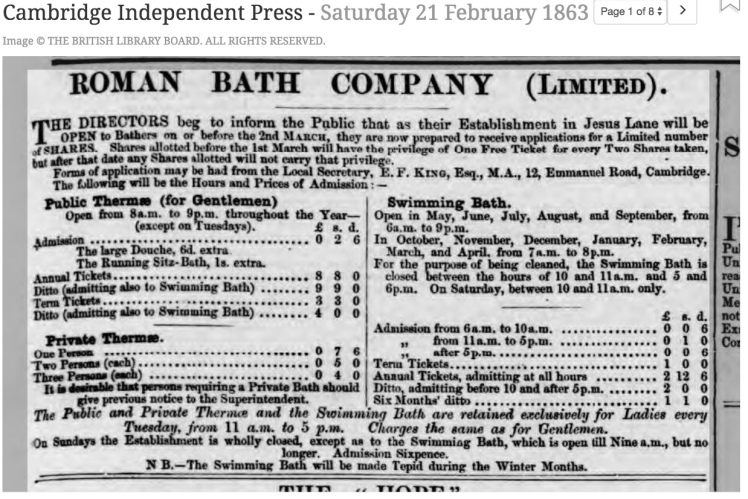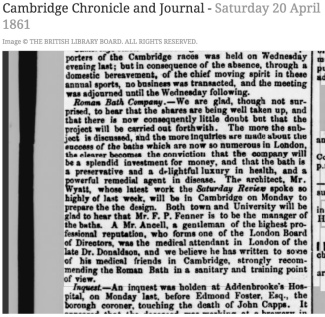Summary
So…what happened?
Bad management or someone running off with all of the money by the sounds of it. The building is this one. The full story has already been summarised in this article by Malcolm Shifrin. But as I only discovered the scans of the original newspaper articles the day before, I’d like to think that there’s a little more to it than “Baths open – oops, where did all the money go…Baths close” as the headlines might indicate.

The building belongs to the Pitt Club – described as Cambridge’s answer to the Bullingdon Club. Make of that what you will. This article is not about what rich Cambridge University students get up to inside their private club premises. I’ll leave that for someone else’s blog. The building today is leased on the ground floor to Pizza Express, and in the basement to a club called the Hidden Rooms, though during my teens it was called Po Na Na’s. I went to a handful of 18th birthday parties there during Upper Sixth/Year 13.
I’ve always found it as a bit of a random building tucked in between your standard Georgian/Victorian brick buildings found all over the place. Those buildings around the club have always had local traders selling their wares – including at one point a big motor garage around the corner!

From G-Maps, the dome of the Round Church is in the top left corner. Jesus Lane goes from South to East in a north-easterly direction. In between the two orange blobs is the entrance to the Pitt Club – previously the Roman Baths. The plan of the original baths can be seen in a diagram here. Note the old Hoop Hotel seems to have been just below where the main long-roofed building is in the top left of the photo above

From A history of Cambridgeshire Cricket
…and the garage I mentioned earlier was the old King and Harper Garage.

From the Cambridgeshire Collection – advert for King & Harper Garage in the Cambridge Chronicle 15 July 1920.
“Yeah – but what about the baths?”
The advantage I may have had over Mr Shifrin judging by the style & fonts he uses, is my use of the British Newspaper Archive (BNA) online – which allows keyword searches. Hence pulling out the articles that he has is testament to his very good research skills! (The text in the newspapers is incredibly small and not easy to spot!)
The articles about the Roman Bath Company that the BNA contains date from between 1861-64, (thus spanning much of the American Civil War) and contain 58 individual references. The first one – understandably, being an advert for people to subscribe for shares.

 From the British Newspaper Archive.
From the British Newspaper Archive.
Although Mr Shifrin states it wasn’t clear what the response to the offer was (see here), keyword searching in the BNA has enabled me to zoom in and spot the response from would be shareholders – which sounded positive.
Articles on 13 & 20 April 1861 indicate that the £3,000 needed for the bath in Cambridge had been raised, and directors were content to go ahead. The site on Jesus Lane was secured shortly afterwards. At the end of May, the first designs from the architect Sir Digby Wyatt went public – along with news of negotiations with the Cambridge Water Company.

Note the arrangement between the Cambridge Waterworks Company and the Roman Baths Company. Note too the concern that the Cambridge shareholders needed to have local men in their ranks.
Mr Shifrin has put a sketch of the ground floor on his page here. Note the presence of the plunge pool – now one of the main dining rooms of Pizza Express.

Pizza Express dining room, From Wikimedia here.
Note the plunge pool was originally inside the four columns.
“How much did it cost to use the baths?”
When the baths finally opened, the Cambridge Independent published the price list below.

Looking at the dimensions of the swimming bath – 56ftx22ft it’s about the size of a small indoor pool you’d see in a commercial gym. About 18m x 7m, so not particularly big. Water charges and heating charges must have been prohibitive. If we go back to May 1862, we discover that costs for furnishing the baths had not been accounted for, which added over 10% to the final cost.

But local shareholders had concerns…

…which would come to bite them.
Because when the shareholders had their annual meeting in Cambridge, all hell broke lose. First of all, the Cambridge shareholders rocked up to the Guildhall, while the London shareholders turned up to the Hoop Hotel on Bridge Street. The Mayor of Cambridge – in the chair as patron but not particularly willingly due to as he said not being familiar with the detail, opened proceedings.
It was then that Mr C Foster of the Cambridge banking family (Note the signs for ‘Fosters Bank’ on the grand Lloyds Bank building where St Andrew’s St meets Hobson St) broke the bad news.

***Who ran off with the money?*** Or what happened to the £4,000 raised? Clearly it had been spent, but not on paying off the creditors, and not on covering the mortgage on the property. The main director, Septimus Beardmore offered his resignation – but also threatened to sue the company to ensure he got his pay for his work as director.

The Mr Sayle mentioned above is more than likely to be one of the finest men to have lived and worked in Cambridge – Mr Robert Sayle, who founded the great department store that got taken over by the John Lewis Group. Many of us locals hoped the group would keep on the Robert Sayle name with the revamped Grand Arcade, but multinational branding talked. Robert Sayle was also a local philanthropist, raising money to help found The Leys School, and the wonderful but now long lost Wesleyan Methodist Chapel on Hills Road.

Robert Sayle’s masterpiece, demolished in the early 1970s. This from the Museum of Cambridge. The pub next door was called The House of Commons.

Janet Wheeler from one of Cambridge’s local history groups provided this wonderful photo of her parents on their wedding day in 1956, giving us a glimpse of what it was like inside.
Back to the Roman Baths
Septimus Beardmore was not popular at all with the local shareholders – the other Foster member – H Foster stating he’d never serve on a company board with Beardmore ever again. There seemed to be two reports presented to the board – one from the London directors and one from the Cambridge directors – the latter saying they could not trust the London report at all. Furthermore, building costs were £1,600 more than contracted.
Despite further price cuts to increase business, and an attempt to lease the entire premises out to an outside company, the firm was wound up in the High Court.

What was left that could be sold off was sold off, but the investors were left with very burnt pockets.

Two years later, The Pitt Club moved in.


My comment concerns King and Harper,, as a child I was taken to their garage to see Sir Henry Seagraves World Speed Record Breaking car The Golden Arrow, as an extra treat we were given a toy gun that fired paper discs,
LikeLike
I really enjoyed your article and learned much from it. Many thanks for your kind mentions of my website article and, my goodness, how right you are about how difficult it all was before the British Newspaper Archive. And not just newspapers. For company information I scanned endless pages of guard books at the then PRO taking days on end; now a click on the online catalogue and its all there in seconds. I hope they keep the guard books though in case anyone tries a British Library catalogue hijack.
LikeLike